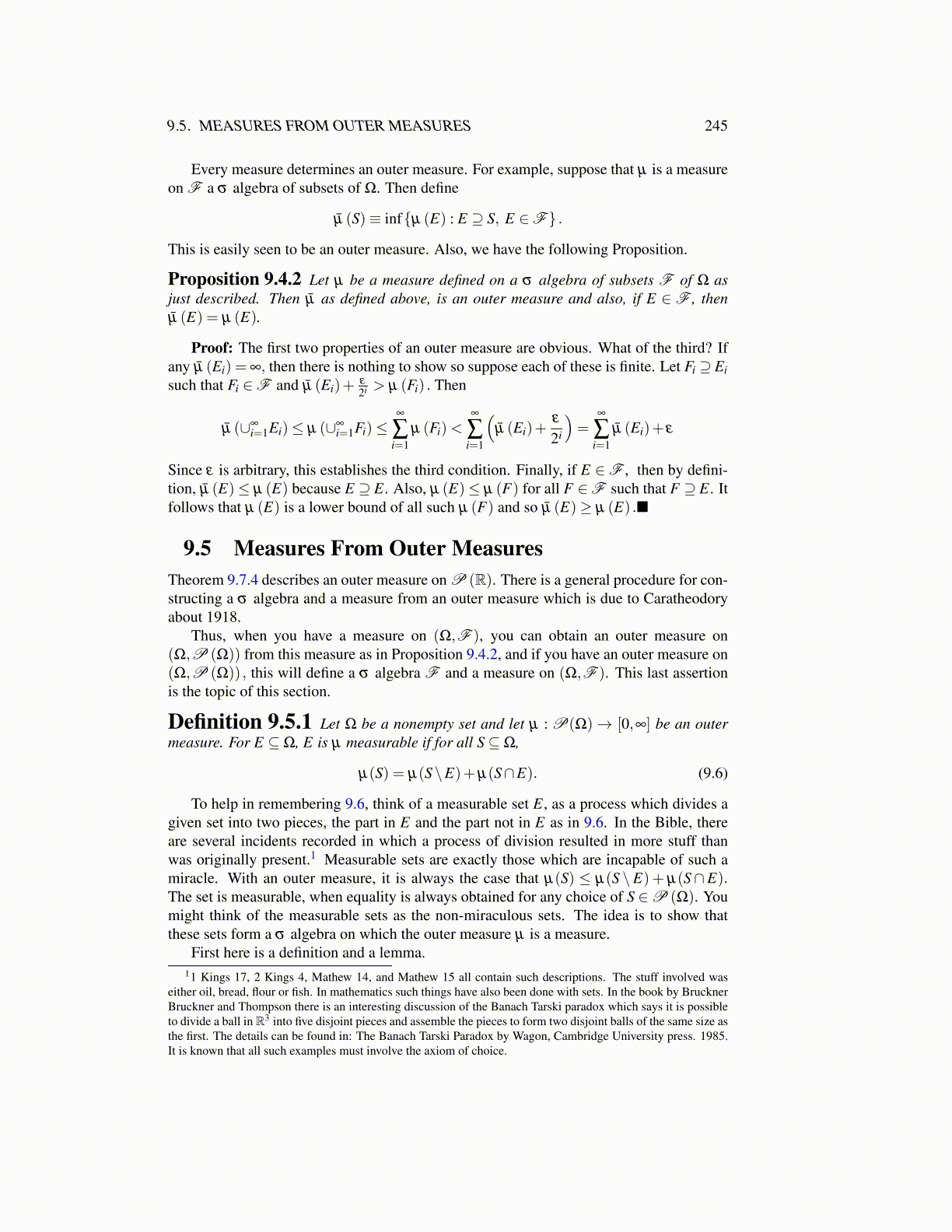
9.5. MEASURES FROM OUTER MEASURES 245
Every measure determines an outer measure. For example, suppose that µ is a measureon F a σ algebra of subsets of Ω. Then define
µ̄ (S)≡ inf{µ (E) : E ⊇ S, E ∈F} .
This is easily seen to be an outer measure. Also, we have the following Proposition.
Proposition 9.4.2 Let µ be a measure defined on a σ algebra of subsets F of Ω asjust described. Then µ̄ as defined above, is an outer measure and also, if E ∈ F , thenµ̄ (E) = µ (E).
Proof: The first two properties of an outer measure are obvious. What of the third? Ifany µ̄ (Ei) = ∞, then there is nothing to show so suppose each of these is finite. Let Fi ⊇ Eisuch that Fi ∈F and µ̄ (Ei)+
ε
2i > µ (Fi) . Then
µ̄ (∪∞i=1Ei)≤ µ (∪∞
i=1Fi)≤∞
∑i=1
µ (Fi)<∞
∑i=1
(µ̄ (Ei)+
ε
2i
)=
∞
∑i=1
µ̄ (Ei)+ ε
Since ε is arbitrary, this establishes the third condition. Finally, if E ∈F , then by defini-tion, µ̄ (E)≤ µ (E) because E ⊇ E. Also, µ (E)≤ µ (F) for all F ∈F such that F ⊇ E. Itfollows that µ (E) is a lower bound of all such µ (F) and so µ̄ (E)≥ µ (E) .■
9.5 Measures From Outer MeasuresTheorem 9.7.4 describes an outer measure on P (R). There is a general procedure for con-structing a σ algebra and a measure from an outer measure which is due to Caratheodoryabout 1918.
Thus, when you have a measure on (Ω,F ), you can obtain an outer measure on(Ω,P (Ω)) from this measure as in Proposition 9.4.2, and if you have an outer measure on(Ω,P (Ω)) , this will define a σ algebra F and a measure on (Ω,F ). This last assertionis the topic of this section.
Definition 9.5.1 Let Ω be a nonempty set and let µ : P(Ω)→ [0,∞] be an outermeasure. For E ⊆Ω, E is µ measurable if for all S⊆Ω,
µ(S) = µ(S\E)+µ(S∩E). (9.6)
To help in remembering 9.6, think of a measurable set E, as a process which divides agiven set into two pieces, the part in E and the part not in E as in 9.6. In the Bible, thereare several incidents recorded in which a process of division resulted in more stuff thanwas originally present.1 Measurable sets are exactly those which are incapable of such amiracle. With an outer measure, it is always the case that µ(S) ≤ µ(S \E)+ µ(S∩E).The set is measurable, when equality is always obtained for any choice of S ∈P (Ω). Youmight think of the measurable sets as the non-miraculous sets. The idea is to show thatthese sets form a σ algebra on which the outer measure µ is a measure.
First here is a definition and a lemma.11 Kings 17, 2 Kings 4, Mathew 14, and Mathew 15 all contain such descriptions. The stuff involved was
either oil, bread, flour or fish. In mathematics such things have also been done with sets. In the book by BrucknerBruckner and Thompson there is an interesting discussion of the Banach Tarski paradox which says it is possibleto divide a ball in R3 into five disjoint pieces and assemble the pieces to form two disjoint balls of the same size asthe first. The details can be found in: The Banach Tarski Paradox by Wagon, Cambridge University press. 1985.It is known that all such examples must involve the axiom of choice.